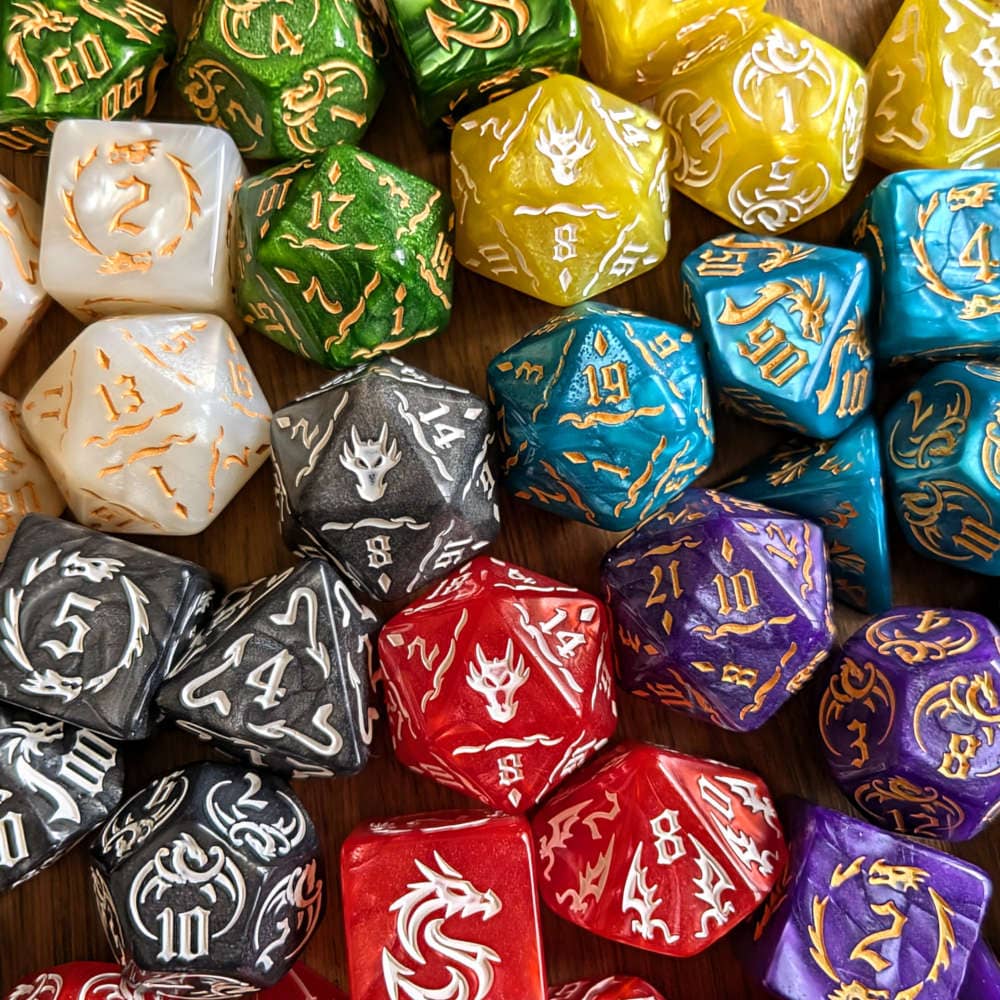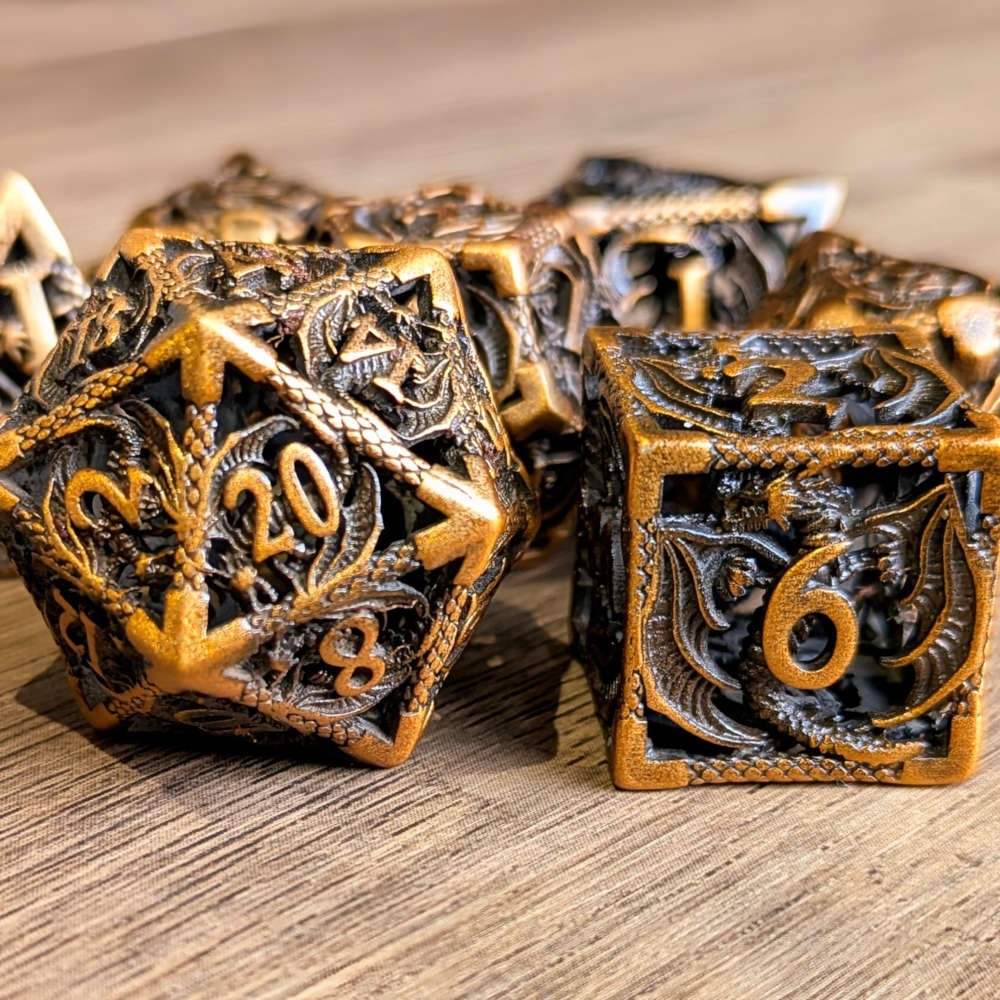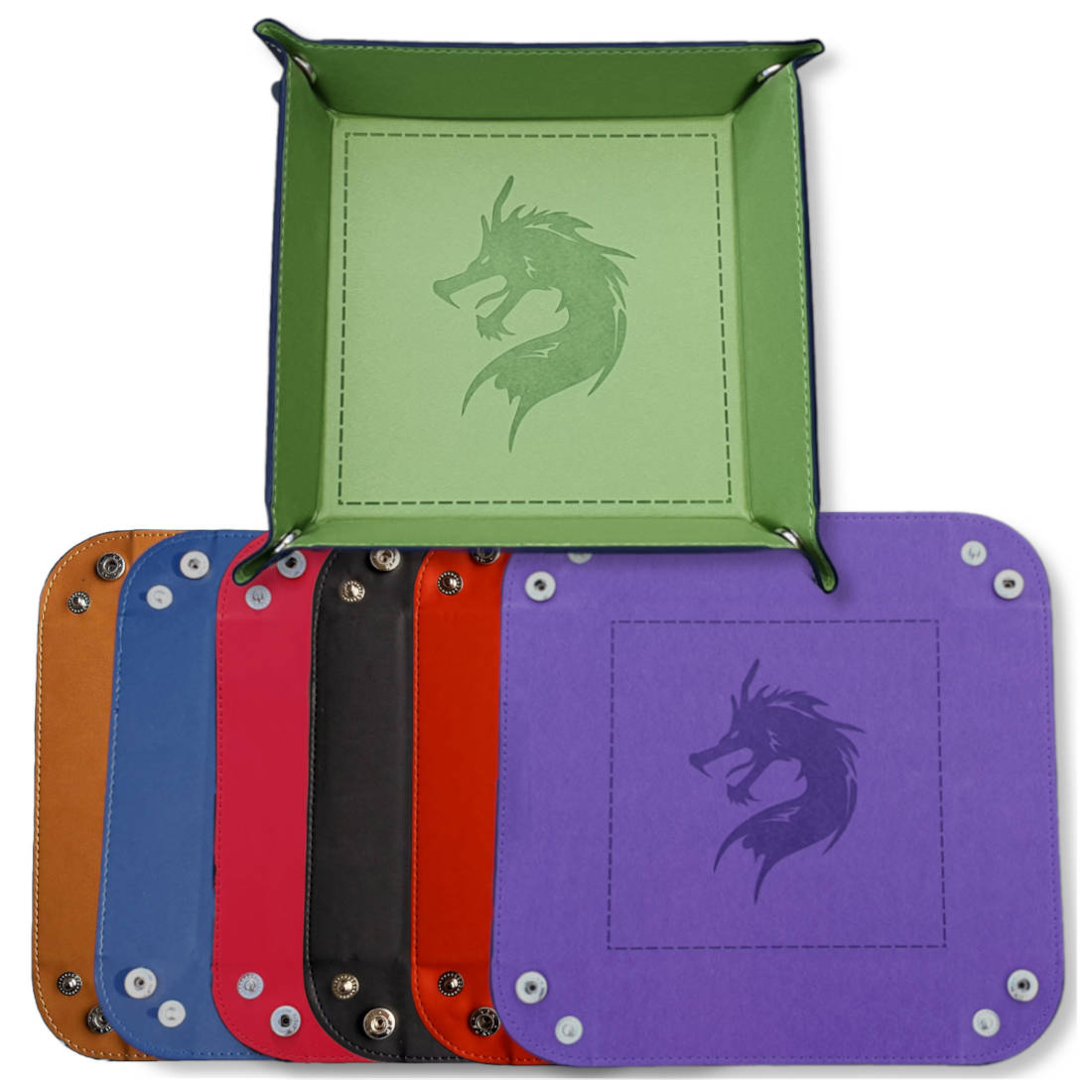Gem dragons in D&D

Gem dragons are a fascinating and enigmatic group of dragons that the mystical worlds of D&D. With their radiant beauty, unique abilities, and rich lore, gem dragons offer players a wealth of storytelling opportunities and gameplay experiences.
In this guide, we'll explore everything you need to know about gem dragons, including their origins, types, characteristics, abilities, and habitats. We’ll also explore the sixth gem dragon that wasn’t included in Fizban’s Treasury of Dragons; the obsidian dragon.
What are the gem dragons?
Gem dragons are a unique breed of dragons in Dungeons & Dragons, characterised by their crystalline scales and psionic abilities. Unlike their chromatic or metallic counterparts, gem dragons are neutrally aligned and are often aloof and self-absorbed.
Preferring solitude, they are commonly found on the Inner Planes or at the far reaches of the Material Plane, distancing themselves from worldly affairs. Despite their isolation, they hold a strong disdain for aberrations like mind flayers and aboleths, often becoming fierce adversaries when encountering such creatures.
How many gem dragons are there?
Gemstone dragons have been a fascinating aspect of Dungeons & Dragons lore since their inception, debuting in the Dungeons & Dragons Basic Set and further expanded upon in 2nd Edition.
However, it wasn’t until the release of Fizban’s Treasury of Dragons in Dungeons & Dragons 5th Edition that the five distinctive gem dragons; amethyst, crystal, emerald, sapphire, and topaz; were reintroduced to the game.
There are 6 types of gem dragons: amethyst, crystal, emerald, sapphire, topaz, and obsidian. However, in D&D 5e, only five types exist, excluding obsidian. The obsidian dragon never made it into Fizban’s Treasury of Dragons.
Amethyst dragon
Amethyst dragons are the mightiest of the gem dragons, with a keen interest in studying and manipulating the fundamental principles of the multiverse through their innate psionics. Despite their power, they are typically aloof and prefer observation over direct interaction, though they may offer guidance to those they find intriguing or useful.

Credit: Joshua Raphael.
In terms of appearance, amethyst dragons start with dull, opaque purple scales when hatched, but as they grow, their scales become more vibrant and translucent, resembling rich purple amethyst crystals. Their crystalline horns hover behind their heads, held by telekinetic force and shifting with their moods.
As they age, their eyes lose their colour, resembling glowing white or pale lavender orbs. They are known to reside in remote and secluded areas, often in regions where the influence of the Far Realm is felt, as they oppose its corruption and seek to understand its nature.
In combat, amethyst dragons are formidable opponents, utilising their innate psionics and a breath weapon empowered by gravitational force to control the battlefield. Additionally, they are skilled in arcane magic and often hoard knowledge and magical artifacts related to the planes of existence and cosmic forces, making their lairs treacherous for those who seek to plunder their wealth.
Crystal dragon
Crystal dragons are radiant beings with an innate psionic connection to the Positive Plane, imbuing them with light and a nurturing disposition. Despite their intimidating appearance, crystal dragons are the friendliest of the gem dragons, often adopting abandoned eggs or hatchlings and fiercely opposing destructive forces in their territories.
They prefer to inhabit desolate, frigid regions, where they construct ice and snow structures reminiscent of castles, open to the sky and adorned with glittering crystals that glow with gathered starlight.

Credit: Fizban’s Treasury of Dragons.
At birth, crystal dragons have dull gray scales, blending into rocky terrain for camouflage, but as they age, their scales turn snow white and slowly fade to transparency, reflecting their connection to the radiant energy of the Positive Plane. Their horns and spines, hovering close to their heads and backs, shimmer with starlight and shift with their moods, expressing anger, fear, suspicion, or amusement.
Many crystal dragons study the stars, interpreting them as omens and glimpses of potential futures, and they foster a nurturing, optimistic attitude, often raising abandoned hatchlings and opposing destructive forces in their territories.
In combat, crystal dragons use their innate psionic abilities and control over radiant energy to their advantage. They are skilled in predicting future events and may use their knowledge to outmanoeuvre opponents. Their lairs are cunningly constructed with ice and snow structures, equipped with blinds and secret passages for stealth and protection.
Emerald dragon
Emerald dragons are the most curious, cunning, and manipulative of the gem dragons. They wield psionic power to weave illusions, allowing them to deceive and disorient others while cloaking their own presence. Shy yet inquisitive, emerald dragons observe local settlements and peoples from afar, using their abilities to blend in and gather information on various phenomena, magical or otherwise.

Credit: Fizban’s Treasury of Dragons.
At birth, emerald dragons have dull, pale green scales, evolving into richer shades as they age, eventually becoming translucent and shimmering in the light. Their horns and spines hover above their bodies, mirroring their mood and movements. Emerald dragons prefer volcanic lairs, dwelling deep within the earth in caverns, lava tubes, and tunnel networks. Their psychic presence extends into the surrounding land, luring giant lizards to settle in the region, which serve as their preferred food source.
In combat, emerald dragons use their cunning and illusionary abilities to confuse and outmanoeuvre opponents. They meticulously plan their lairs, using natural features and illusion magic to conceal hoard chambers and trap intruders. Emerald dragons prize knowledge, particularly local histories and magical events, and collect magic items and spells related to illusions to better conceal their treasures.
Sapphire dragon
Sapphire dragons are known for their territorial nature and militaristic tendencies. They collect magical weapons and armour as prized possessions, often vaulting them away in isolated caverns. Their psionic abilities manifest in their unique horn and bone structures, which float and shift with the dragon's mood, reflecting their powerful psychic force.

Credit: Aggrav.
These dragons boast scales and wing membranes of varied shades of blue, reminiscent of the crystalline azure of sapphire gems. Their glittering scales shine with luminous starburst images, adding to their majestic appearance. From hatchling to adulthood, sapphire dragons retain their rich blue scales and sparkling lustre, distinguishing them from other dragons.
Sapphire dragons dwell in massive caverns and tunnel networks deep within the earth, sculpting secret passages and hidden blinds to navigate their lairs and ambush intruders. They are formidable opponents, devising strategies and using their natural abilities such as their thunder breath weapon to defend their territory.
Topaz dragon
Topaz dragons are embodiments of decay, reflecting mortality and decomposition. Despite their morbid demeanour, they are not inherently evil, viewing destruction as a natural process that clears the way for renewal and growth. Generally solitary creatures, topaz dragons prefer solitude and can be irritable when disturbed, but those who endure their abrasive nature may find a powerful ally in them.

Credit: GammaRae.
Upon hatching, topaz dragon wyrmlings have dull yellow-orange scales, which clarify and become translucent as they age, ranging in colour from bright yellow to rich amber. Their bodies are wide at the haunches and taper toward the head, with wings designed for both aerial and aquatic propulsion. Notably, gem-like spines hover above their backs, shifting with the dragon's mood and manifesting their psionic power visibly.
In combat, topaz dragons use their psionic abilities to manipulate necrotic energy and decay. They have a penchant for reducing structures and plant life to dust, clearing the way for new growth. Their fascination with destruction extends to their hoards, which contain information on creation and destruction, as well as magical artifacts related to negative energy manipulation.
Obsidian dragon
Obsidian dragons, although not featured in Fizban's Treasury of Dragons, are another type of gem dragon known for their cruelty and intelligence. These dragons derive pleasure from inflicting suffering on their prey and are notorious for their haughty demeanour and quick temper. Preferring to toy with their victims before delivering the final blow, obsidian dragons make their homes in volcanoes on the Material Plane and in the Elemental Plane of Fire.

Credit: Bruno Cesar.
At birth, obsidian dragons have gray, rough scales that sharpen into smooth black skin with razor edges as they age. Their scales blend seamlessly, giving them a sleek and formidable appearance. Most obsidian dragons choose to reside near volcanoes or in the mountains of coal within the Elemental Plane of Fire, though some great wyrms use their powers to create their own demi-planes.
In combat, obsidian dragons show calculated aggression, quickly assessing their opponents to determine if victory is assured. If faced with formidable foes, they retreat to strategise or set up ambushes. They employ cunning tactics such as snatching opponents and plane shifting them to hostile environments like the Elemental Plane of Fire or their own demi-plane to secure victory.
Are gem dragons good or evil?
Gem dragons, unlike metallic or chromatic dragons, are neutral-aligned and categorized by gem type rather than colour or metal. Though neutral, they can lean toward egotism, showcasing a spectrum of behaviours rather than strict good or evil tendencies.
Who is the God of gem dragons?
In the pantheon of dragons, where Bahamut and Tiamat reign supreme over metallic and chromatic dragons, Sardior is the deity who oversees gem dragons. Known as the ruby dragon, Sardior resides within a floating city crafted from ruby and red gold, concealed and visible only under the cover of darkness.
Mirroring Bahamut's council of seven golden canaries in his human form, Sardior convenes with a council of five ancient gem dragons, each representing a different variety of gem dragon.
Commonly asked gem dragon questions
Let’s explore some frequently asked questions about gem dragons and help shine a light on this beautiful class of dragons.
Can gem dragons fly?
Yes, gem dragons can fly, just like their chromatic and metallic counterparts. Their formidable wings allow them to soar through the skies with grace and agility, adding to their formidable presence on the battlefield.
Can you befriend a gem dragon?
It's possible to befriend a gem dragon. Unlike chromatic dragons, gem dragons aren't inherently hostile, but they generally remain aloof and focused on their own interests. Building rapport and offering mutual benefits might persuade them to aid, albeit cautiously.
Just like having a dragon as a pet, it depends on how your Dungeon Master decides to fit gem dragons into your campaign.
Can gem dragons change shape?
Yes, gem dragons possess the ability to change shape, much like other dragons. Through magical means, they can transform into creatures that are Medium or Small in size while maintaining their original game statistics, offering them versatility and adaptability in various situations.
How do gem dragons interact with people?
Gem dragons tend to be aloof and elusive, preferring to observe rather than engage directly with people. However, they may interact with individuals they find intriguing or useful, often employing subtle manipulation or offering cryptic guidance rather than direct assistance.
If your party looks like they may get into a fight with a gem dragon, The Monsters Know has a fantastic guide to gem dragon tactics and how best to run them in combat.
Are gem dragons considered true dragons?
Yes, gem dragons are considered true dragons in D&D. While the definition has of true dragon has changed over time, gem dragons possess draconic traits, including breath weapons and formidable abilities, aligning them with the classification of true dragons.
What do gem dragons think of chromatic and metal dragons?
Gem dragons generally view chromatic and metallic dragons with disdain or indifference. They prefer to distance themselves from conflict and rivalry, focusing instead on their own pursuits and agendas.
Draconic dice and accessories
Now that you know what there is to know about gem dragons, why not infuse a bit of their mystique into your gaming setup? Explore our collection of metal dice that embody the strength of dragons. Or, for a more eye-catching touch, consider our dragon eye dice sets.
If you're seeking tabletop accessories to accompany you on your adventures, look no further than our dragon journal planner. This notebook serves as a sanctuary for your tabletop notes, character sketches, campaign ideas, or anything else essential to your gaming journey.





